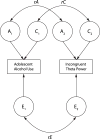Testing the effects of adolescent alcohol use on adult conflict-related theta dynamics
- PMID: 28935223
- PMCID: PMC5675801
- DOI: 10.1016/j.clinph.2017.08.019
Testing the effects of adolescent alcohol use on adult conflict-related theta dynamics
Abstract
Objective: Adolescent alcohol use (AAU) is associated with brain anomalies, but less is known about long-term neurocognitive effects. Despite theoretical models linking AAU to diminished cognitive control, empirical work testing this relationship with specific cognitive control neural correlates (e.g., prefrontal theta-band EEG dynamics) remains scarce. A longitudinal twin design was used to test the hypothesis that greater AAU is associated with reduced conflict-related EEG theta-band dynamics in adulthood, and to examine the genetic/environmental etiology of this association.
Methods: In a large (N=718) population-based prospective twin sample, AAU was assessed at ages 11/14/17. Twins completed a flanker task at age 29 to elicit EEG theta-band medial frontal cortex (MFC) power and medial-dorsal prefrontal cortex (MFC-dPFC) connectivity. Two complementary analytic methods (cotwin control analysis; biometric modeling) were used to disentangle the genetic/shared environmental risk towards AAU from possible alcohol exposure effects on theta dynamics.
Results: AAU was negatively associated with adult cognitive control-related theta-band MFC power and MFC-dPFC functional connectivity. Genetic influences primarily underlie these associations.
Conclusions: Findings provide strong evidence that genetic factors underlie the comorbidity between AAU and diminished cognitive control-related theta dynamics in adulthood.
Significance: Conflict-related theta-band dynamics appear to be candidate brain-based endophenotypes/mechanisms for AAU.
Keywords: Adolescent alcohol use; Cognitive control; Cotwin control; Endophenotype; Functional connectivity; Theta.
Copyright © 2017 International Federation of Clinical Neurophysiology. Published by Elsevier B.V. All rights reserved.
Conflict of interest statement
None of the authors have potential conflict of interest to be disclosed.
Figures


Similar articles
-
Conflict-related medial frontal theta as an endophenotype for alcohol use disorder.Biol Psychol. 2018 Nov;139:25-38. doi: 10.1016/j.biopsycho.2018.10.002. Epub 2018 Oct 6. Biol Psychol. 2018. PMID: 30300674 Free PMC article.
-
Impact of alcohol use on EEG dynamics of response inhibition: a cotwin control analysis.Addict Biol. 2018 Jan;23(1):256-267. doi: 10.1111/adb.12481. Epub 2016 Nov 18. Addict Biol. 2018. PMID: 27859998 Free PMC article.
-
Theta dynamics reveal domain-specific control over stimulus and response conflict.J Cogn Neurosci. 2012 May;24(5):1264-74. doi: 10.1162/jocn_a_00128. Epub 2011 Aug 23. J Cogn Neurosci. 2012. PMID: 21861681
-
A neural microcircuit for cognitive conflict detection and signaling.Trends Neurosci. 2014 Sep;37(9):480-90. doi: 10.1016/j.tins.2014.06.004. Epub 2014 Jul 14. Trends Neurosci. 2014. PMID: 25034536 Review.
-
Frontal theta as a mechanism for cognitive control.Trends Cogn Sci. 2014 Aug;18(8):414-21. doi: 10.1016/j.tics.2014.04.012. Epub 2014 May 15. Trends Cogn Sci. 2014. PMID: 24835663 Free PMC article. Review.
Cited by
-
Target-related parietal P3 and medial frontal theta index the genetic risk for problematic substance use.Psychophysiology. 2019 Aug;56(8):e13383. doi: 10.1111/psyp.13383. Epub 2019 Apr 23. Psychophysiology. 2019. PMID: 31012496 Free PMC article.
-
The Effects of Alcohol and Cannabis Use on the Cortical Thickness of Cognitive Control and Salience Brain Networks in Emerging Adulthood: A Co-twin Control Study.Biol Psychiatry. 2021 May 15;89(10):1012-1022. doi: 10.1016/j.biopsych.2021.01.006. Epub 2021 Jan 20. Biol Psychiatry. 2021. PMID: 33726938 Free PMC article.
-
Conflict-related medial frontal theta as an endophenotype for alcohol use disorder.Biol Psychol. 2018 Nov;139:25-38. doi: 10.1016/j.biopsycho.2018.10.002. Epub 2018 Oct 6. Biol Psychol. 2018. PMID: 30300674 Free PMC article.
-
Risk Behaviors in Teens with Chronic Kidney Disease: A Study from the Midwest Pediatric Nephrology Consortium.Int J Nephrol. 2019 Dec 4;2019:7828406. doi: 10.1155/2019/7828406. eCollection 2019. Int J Nephrol. 2019. PMID: 31885919 Free PMC article.
-
An electroencephalographic signature predicts craving for methamphetamine.Cell Rep Med. 2024 Jan 16;5(1):101347. doi: 10.1016/j.xcrm.2023.101347. Epub 2023 Dec 26. Cell Rep Med. 2024. PMID: 38151021 Free PMC article.
References
-
- American Psychiatric Association. Diagnostic and statistical manual of mental disorders. 4th. Washington, DC: Author; 1994.
-
- Anokhin AP, Golosheykin S, Heath AC. Heritability of frontal brain function related to action monitoring. Psychophysiology. 2008;45:524–34. - PubMed
-
- Bates D, Maechler M, Bolker B, Walker S. Fitting linear mixed-effects models using lme4. J Stat Softw. 2015;67:1–48.
-
- Begg MD, Parides MK. Separation of individual-level and cluster-level covariate effects in regression analysis of correlated data. Stat Med. 2003;22:2591–602. - PubMed
-
- Bell AJ, Sejnowski TJ. An information maximization approach to blind separation and blind deconvolution. Neural Comput. 1995;7:1129–59. - PubMed
Publication types
MeSH terms
Grants and funding
LinkOut - more resources
Full Text Sources
Other Literature Sources

